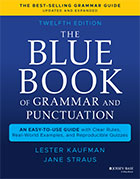|
Numbers can often present different style questions in American English. When should we spell them, and when shouldn't we? In particular, what are ordinal numbers and what are cardinal numbers, and how do we treat them? Mastering these distinctions will refine your precision in your daily writing.
For this discussion, we'll review style guidance from our two primary supporting references, The Associated Press Stylebook and The Chicago Manual of Style.
AP is popular style for everyday communications such as newspapers, magazines, and online journalism. CMOS is widely regarded as a style authority for more-formal publications such as books and academic writing. You can choose to follow the style format that is best suited to you and your audience.
What Are Ordinal Numbers?
Ordinal numbers are those that indicate rank, order, or position. Ordinal numbers do not express quantities, an important distinction from cardinal numbers.
Concerning ordinal numbers, AP advises to spell out first through ninth:
Keersten just won the sixth gold medal of her illustrious ice-skating career.
That is the fourth guitar string I've broken in the last few weeks. |
For ordinal numbers greater than ninth, AP directs to use figures:
Vithu recently celebrated his 30th birthday.
Jean has crossed her 13th mile of the marathon. |
The Chicago Manual of Style advises to spell out first through one hundredth:
Vithu recently celebrated his thirtieth birthday.
I'm pretty sure that's the one hundredth time you told me that. |
For ordinal numbers greater than one hundredth, CMOS directs to use figures:
Today is the 175th anniversary of the founding of the village.
The labor strike has reached its 205th day. |
What Are Cardinal Numbers?
Cardinal numbers—also known as counting numbers—are used to specify quantities (i.e., they identify how many). They are what come to mind most often when we think of numbers. Unlike ordinal numbers, they do not specify rank, order, or position.
AP advises to spell out one through nine:
Blaine has two dogs, and Ray-Ray has five.
Gator was held back after his junior year of high school, so he went to three total proms. |
For cardinal numbers greater than nine, AP typically directs to use figures:
Victor owns 32 miniature replicas of different types of airplanes.
The labor strike has reached day 205. |
CMOS advises to spell out one through one hundred:
Blaine has two dogs, and Ray-Ray has five.
Victor owns thirty-two miniature replicas of different types of airplanes. |
For cardinal numbers greater than one hundred, CMOS directs to use figures:
The state-park expansion now includes an additional 220 acres for wildlife preservation.
That rampart is 1,185 years old. |
The exceptions to this CMOS guideline are whole numbers combined with hundred, thousand, hundred thousand, million, billion, etc.
Approximately two hundred thousand people attended the city parade and celebration.
Scientists estimate the earth to be more than four billion years old. |
Ordinal vs. Cardinal: Tips for Remembering
Even after a good review, the difference between ordinal and cardinal numbers can sometimes still be evasive.
One device for recalling the distinction is to associate ordinal with the concept of order. Ordinal numbers also will not be expressed as counting digits (one, five, ten, etc.) and, when written, will usually include a suffix: 10th, 35th, 101st.
Similarly, you can remind yourself that cardinal relates to counting, and both words begin with a c.
A Note About Nominal Numbers
Certain numbers can be classified as nominal numbers. This means that they identify something as opposed to counting or ordering it. Just a few examples might be a zip code, a telephone number, or a sports player's uniform number.
Examples
Jason lives somewhere in Beverly Hills 90210.
The new number for Doggie Dearest Grooming is 888-555-3644.
We will always remember the Chicago Bears' legendary 34, Walter Payton. |
A Note About Placement and Consistency
We've reviewed the primary basics for treating numbers in your writing according to a more-formal style (CMOS) or a daily, slightly less-formal style (AP).
There are two more leading items to keep in mind that both AP and CMOS agree on.
1) If a sentence begins with a number, the number is typically spelled out:
Forty years is a long time to drive the same car.
One hundred twenty students attended the rally. |
If the starting number would be laborious to write out, try rewriting the sentence:
One thousand nine hundred seventy-two people responded to the offer for the free tickets.
The offer for the free tickets attracted 1,972 responses. |
2) It is acceptable to use numerals if multiple items are in a related category or if spelling the numbers would make the content too thick or cumbersome:
Chester's farm includes 12 cows, 5 horses, 34 chickens, and 11 goats.
The ages of the judges on the panel are 64, 38, 29, 53, and 32. |
Related Topics
Rules for Writing Numbers
Writing Dates and Times
Numbers: Words or Numerals?
|





